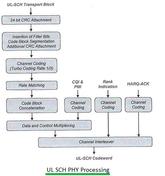LTE QoS and QCI Overview
A concise overview of LTE Quality of Service (QoS) and QoS Class Identifiers (QCIs), including QCI values 1-9, prioritization and how they are applied in an LTE network.
Advertisement
A concise overview of LTE Quality of Service (QoS) and QoS Class Identifiers (QCIs), including QCI values 1-9, prioritization and how they are applied in an LTE network.

Understand the LTE RRC state diagram, including IDLE and Connected modes, for efficient UE communication and battery management.
Overview of LTE Signalling Radio Bearer (SRB) types: SRB0, SRB1, and SRB2. Explains their characteristics, message types, and RLC modes in LTE networks.
An overview of LTE system interfaces like S5, S8, S10, S11, S12, S13, SBc, and X2, explaining their roles in LTE network communication and data transfer.

Overview of LTE system interfaces: S6b, S6c, S6d, S9, Gi, Gx, Gy, Gz, Sp, Rx+, and Wm. Covers functions like mobility authentication, QoS, policy control, and charging.

This page covers LTE testing as per LTE UE compliant to 3GPP conformance test. It covers LTE UE Test and Measurement viz. EVM, receiver sensitivity, maximum power reduction, IQ, spectrum mask, ACLR, RSRP etc.
Explore LTE UE categories 1 to 5, focusing on their data speeds, MIMO configurations, and common applications. Understand how these categories impact device performance and network efficiency.

Learn the LTE UE network entry procedure: cell search, system information decoding, and random access. Essential steps for establishing network entry with an eNB.

Explores the LTE UL-SCH function and the physical layer processing steps for the transmitter, culminating in the generation of the SC-FDMA signal.

Learn about LTE-M (LTE Cat-M1), a Low Power Wide Area (LPWA) technology for IoT, covering architecture, frequency bands, and protocol stack.

Explore the critical role of timing and synchronization in femtocell networks, including techniques and challenges to ensure optimal performance and data integrity.
Explore the multiple access techniques employed in UMTS (3G), including WCDMA, TD-CDMA, and TD-SCDMA, and learn how they enable efficient spectrum use.

Explore LTE bearer types like EPS, E-RAB, S1, S5/S8, and radio bearers. Learn their definitions, purposes, and relationships for QoS-driven communication.

Learn about LTE EPS Connection Management states (ECM IDLE and ECM CONNECTED), their characteristics, and transitions between them in LTE networks.
Explore LTE frequency bands, including FDD, US ranges, and bands used by Verizon and T-Mobile. Essential for network planning and device compatibility.

Explore UMTS frame structure, time slots, and their functions in 3G networks. Learn about frame organization, synchronization channels, and their impact on network performance.

Learn about WCDMA RRC states (idle, connected) and procedures in UMTS. Covers cell selection, connection establishment, and state transitions.
Advertisement